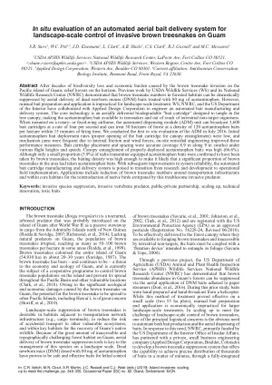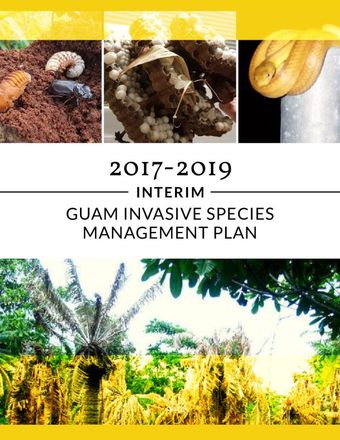In situ evaluation of an automated aerial bait delivery system for landscape-scale control of invasive brown treesnakes on Guam
- Description:
- After decades of biodiversity loss and economic burden caused by the brown treesnake invasion on the Pacific island of Guam, relief hovers on the horizon. Previous work by USDA Wildlife Services (WS) and its National Wildlife Research Center (NWRC) demonstrated that brown treesnake numbers in forested habitats can be dramatically suppressed by aerial delivery of dead newborn mouse (DNM) baits treated with 80 mg of acetaminophen. However, manual bait preparation and application is impractical for landscape-scale treatment. WS, NWRC, and the US Department of the Interior have collaborated with Applied Design Corporation to engineer an automated bait manufacturing and delivery system. The core technology is an aerially delivered biodegradable bait cartridge designed to tangle in the tree canopy, making the acetaminophen bait available to treesnakes and out of reach of terrestrial non-target organisms. When mounted on a rotary- or fixed-wing airframe, the automated dispensing module (ADM) unit can broadcast 3,600 bait cartridges at a rate of four per second and can treat 30 hectares of forest at a density of 120 acetaminophen baits per hectare within 15 minutes of fi ring time. We conducted the first in situ evaluation of the ADM in July 2016. Initial acetaminophen bait deployment rates (proper opening of the bait cartridge for canopy entanglement) were low, and mechanism jams were frequent due to internal friction and wind forces; on-site remedial engineering improved these performance measures. Bait cartridge placement and spacing were accurate (average 8.9 m along 9 m swaths) under various flight heights and speeds. Canopy entanglement of properly-deployed acetaminophen baits was high (66.6%). Although only a small proportion (5.9%) of radio transmitter-equipped acetaminophen baits were confirmed to have been taken by brown treesnakes, the baiting density was high enough to make it likely that a significant proportion of brown treesnakes in the area had taken acetaminophen baits. With subsequent improvements in system reliability, the automated bait cartridge manufacturing and delivery system is poised to transition from research and development to operational field implementation. Applications include reduction of brown treesnake numbers around transportation infrastructure and within core habitats for the reintroduction of native birds extirpated by this troublesome invasive predator.
- Display date:
- 2019
- Collections:
- Secretariat of the Pacific Regional Environment Programme (SPREP)
- Publisher:
- International Union for Nature Conservation (IUCN)
- Content partner:
- Secretariat of the Pacific Regional Environment Programme (SPREP)
- Availability:
- Not specified
-
Copyright status: All rights reservedFind out more about what you are able to do with this itemThis item is all rights reserved, with means you'll have to get permission from Secretariat of the Pacific Regional Environment Programme (SPREP) before using it. For more information, please see our use and reuse page.What can I do with this item?Non-infringing useNZ copyright law does not prevent every use of a copyright work, and this item may be hosted by an international institute or organisation. You should consider what you can and cannot do with a copyright work.No sharingYou may not copy and/or share this item with others without further permission. This includes posting it on your blog, using it in a presentation, or any other public use.No modifyingYou are not allowed to adapt or remix this item into any other works.No commercial useYou may not use this item commercially.
Related items
Welcome and warm Pasifik greetings
The information on this site has been gathered from our content partners.
The names, terms, and labels that we present on the site may contain images or voices of deceased persons and may also reflect the bias, norms, and perspective of the period of time in which they were created. We accept that these may not be appropriate today.
If you have any concerns or questions about an item, please contact us.

